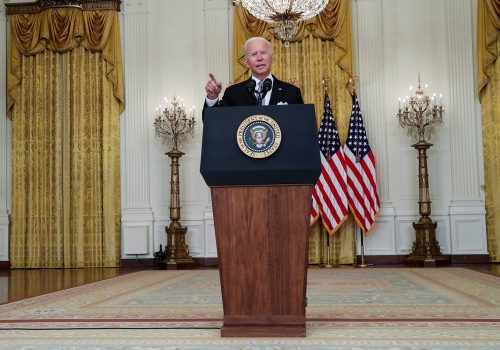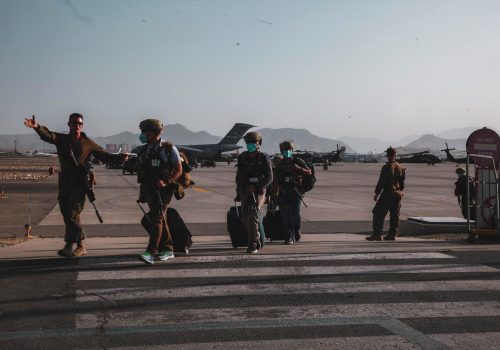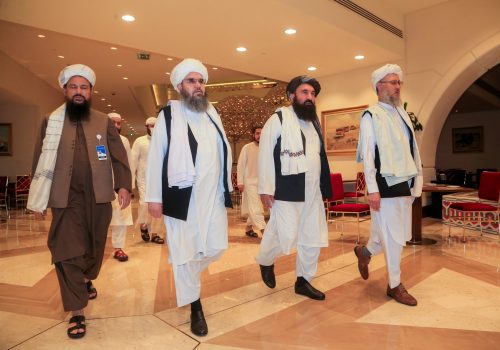FAST THINKING: Will the Kabul airlift succeed?
GET UP TO SPEED
Wheels up. After the swift fall of Kabul, the US military, allies, and non-governmental groups are evacuating thousands of people out of Taliban-controlled Afghanistan. As US President Joe Biden put it today: “This is one of the largest, most difficult airlifts in history.” How is this effort playing out? Where are Afghans going? What could go wrong? Our experts are here to get you ahead of this fast-moving story.
TODAY’S EXPERT REACTION COURTESY OF
- Gen. James L. Jones Jr.: Executive chairman emeritus of the Atlantic Council and former national security advisor to President Barack Obama and NATO Supreme Allied Commander Europe
- Evanna Hu (@evannahu): Nonresident senior fellow at the Scowcroft Center for Strategy and Security and CEO of artificial intelligence company Omelas who has been organizing non-governmental evacuation efforts from Kabul
- Kirsten Fontenrose: Director of the Scowcroft Middle East Security Initiative and former US national-security official
- Amb. James B. Cunningham (@JBCunningham_): Nonresident senior fellow in the South Asia Center and former US ambassador to Afghanistan
The state of play
- The chaotic scramble at Kabul airport is a reflection of how poorly the US withdrawal was conducted, Jones says. “From the operational standpoint, we did this exactly backwards. We evacuated the military first, and then the civilians, and then last but not least… US government employees and our friends and allies.”
- That means US and foreign governments as well as private groups are bringing in aircraft. Hu points to widespread “price gouging” due to the demand for departures and notes that planes are typically allowed only an hour on the runway—meaning if their passengers can’t arrive in time, the planes often leave at only a fraction of capacity. “That is something that we really need help on, especially just better coordination with the State Department and the Marines that are on the ground” to manage these timelines, Hu says.
- The United Nations has been under pressure to take over the evacuation, Fontenrose notes, but that’s not happening. Instead the UN has deployed peacekeepers to help maintain order outside the airport, which she says “is a step forward in terms of the safety of Afghans and those who need to get out.”
- But where will they go? “I bet there are Afghans on those planes who don’t even have any idea where they’re going,” Cunningham says. “It seems there’s no plan yet for supporting these people, let alone moving them on to someplace else eventually.”
Destination unkown
- Fontenrose points out that “Kabul is not the end of the story” even as it gets all the media attention. There are evacuations underway from Herat, Mashhad, and elsewhere, and “this is where the unofficial groups are really the only ones acting” since the US military is long gone.
- Non-governmental actors are taking on a bigger role because of the need for speed and the “hurdles the government must jump in the form of red tape and regulations that are intended to protect the use of taxpayer funds and ensure laws are followed in normal situations,” Fontenrose says.
- “There are some crazy places we are taking Afghan refugees,” Hu notes, from North Macedonia to Brazil, Ukraine, Egypt, and the Dominican Republic. The destinations are often based, she says, on press releases from friendly governments and informal contacts: “A lot of times it’s really just hitting up random networks and seeing who is going to say yes.”
- In all these frantic efforts, there is a silver lining, in Fontenrose’s view: The kind of “bipartisan collaboration” that is exceedingly rare in today’s Washington: “Former government officials and retired military and intelligence officers from both sides of the aisle are working together in hyper-efficient teams, self-organized and self-directed.”
Contingency planning
- Given the Taliban’s “record for cruelty and violence and summary executions,” Jones points out, the United States needs to be planning now for the “worst-case scenario that would cause us to have to reinsert military troops to regain some sense of order.”
- In the meantime, there are reports of shortages of water and food at the airport, which Hu says raises a crucial question: “Why are we flying in empty military aircraft when we could be flying in with boxes and boxes of water and” meals?
- Once those planes depart full of people, Fontenrose says the US government needs to convince allies to resettle more Afghan refugees, in addition to bringing more of them stateside. The informal contacts that have helped engineer the evacuations won’t cut it. “We need massive diplomatic pressure to make that happen—at high levels,” she says. “Or we’re going to have flights not be able to leave because there’s no place to put these people.”
- Stepping back, Cunningham predicts that US allies and partners are increasingly going to view Afghanistan through the prism of the old Colin Powell dictum of foreign policy: You break it, you own it. “The Biden administration needs to recognize that they do own this,” Cunningham says. “And they need to do the best job that they can in fixing it.”
Further reading
Thu, Aug 19, 2021
What Washington owes the American people after its Afghanistan failure
New Atlanticist By Christopher Preble
The discussion about what the United States should do in the aftermath of its war in Afghanistan should proceed in three phases: now, soon, and soon thereafter.
Thu, Aug 19, 2021
Is Kabul airport the next Dien Bien Phu?
New Atlanticist By Harlan Ullman
The 1954 French disaster in Vietnam offers a dangerous parallel to the current US evacuation efforts from Afghanistan.
Sun, Aug 15, 2021
Experts react: The Taliban has taken Kabul. Now what?
Experts react By
Atlantic Council experts, many of whom have spent many years in the trenches on Afghanistan policy, weigh in on the fall of Kabul.
Image: Civilians prepare to board a plane during an evacuation at Hamid Karzai International Airport, in Kabul, Afghanistan on August 18, 2021. Photo via US Marine Corps/Staff Sgt. Victor Mancilla/Reuters.


